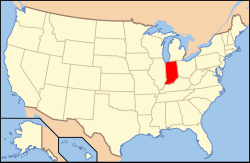Indiana wine is wine made from grapes grown in the U.S. state of Indiana. Wine has been produced in the area since the early days of European colonization in the 18th century. In the mid-19th century, Indiana was the tenth-largest winegrape producing state in the country. There are two American Viticultural Areas (AVA) in Indiana: the Ohio River Valley AVA which also contains portions of Kentucky and Ohio, and the Indiana Uplands AVA which is wholly located in south-central Indiana and includes the oldest and most prolific winery in Indiana, Oliver Winery.
| Wine region | |
 | |
| Official name | State of Indiana |
|---|---|
| Type | U.S. state |
| Year established | 1816 |
| Country | United States |
| Sub-regions | Indiana Uplands AVA |
| Climate region | Continental/humid subtropical |
| Total area | 36,418 square miles (94,322 km2)[1] |
| Size of planted vineyards | 270 acres (109 ha)[1] |
| No. of vineyards | 30[1] |
| Grapes produced | Aurore, Baco noir, Cabernet Franc, Cabernet Sauvignon, Catawba, Cayuga, Chambourcin, Chardonel, Chardonnay, Concord, Geisenheim, Gewürztraminer, Leon Millot, Marechal Foch, Merlot, Muscat Canelli, Niagara, Pinot gris, Pinot noir, Riesling, Sauvignon blanc, Seyval blanc, St. Vincent, Steuben, Traminette, Vidal blanc, Vignoles, Villard blanc, Viognier[1] |
History
editIndiana was a crucial area in the early American wine industry.[2] Early attempts at grape cultivation were mainly undertaken by English immigrants,[3] which were all unsuccessful in the production of palatable wine. French vinedressers were blamed for intentionally causing this failure even though this was not the case.[4] French cultivation of grapes started in what would be present-day Indiana by 1735.[5] Reasons that wine production failed in this era included the inability to use native grapes (which were too bitter[3] and produced less fruit[4]), the lack of mature vineyards,[4] diseases that non-native grapes were especially weak to, and a colder climate compared to Europe.[6] Vinyards were abandoned for tobacco, which was a more profitable crop.[4] More serious attempts to produce wine took place after the American Revolution but these efforts were also unsuccessful.[7]
References
edit- ^ a b c d "Indiana: Appellation Profile". Archived from the original on September 3, 2013. Retrieved November 16, 2007.
- ^ Butler & Butler 2001, p. xi.
- ^ a b Butler & Butler 2001, p. 1.
- ^ a b c d Butler & Butler 2001, p. 2.
- ^ Butler & Butler 2001, p. 5.
- ^ Butler & Butler 2001, p. 3.
- ^ Butler & Butler 2001, p. 4.
Sources
edit- Butler, James; Butler, John (2001). Indiana Wine: A History. Indiana University Press. pp. xi-264. ISBN 9780253000583.